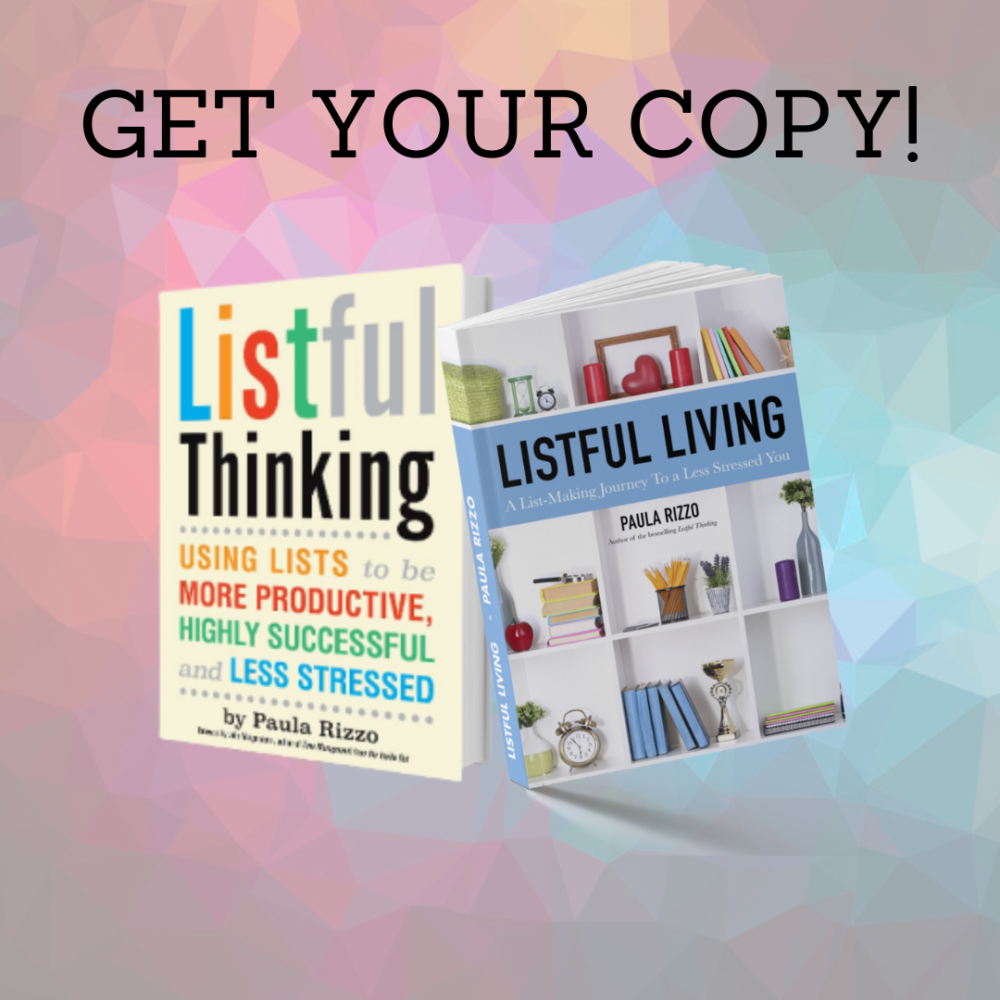Apps and Resources to Make Travel Less Stressful
___
BONUS FREEBIE: Want even more ways to stay organized, productive and less stressed? CLICK HERE to get access to my List-Making Starter Kit. It will boost your efficiency and get you back to doing more of the things you love.
___
I love taking trips to new places and revisiting my favorite spots — it’s one of the best ways to get out of your comfort zone and shift your perspective. I do as much traveling as I can and as a productivity expert, I’ve come up with some strategies to reduce my stress so I can focus on relaxing and having fun. The planning can even be enjoyable, if you approach it the right way.
Because let’s face it — traveling can be stressful! You’re not alone if planning trips and figuring out the logistics sometimes feels like more trouble than it’s worth.
Luckily, there are some wonderful apps and resources for taking a lot of the stress and hassle out of this process! I chatted with PIX11 News in New York City about my top tips.
Before you leave:
Wikivoyage: This website has so much information for planning and learning about countries. It’s like Wikipedia but it’s geared towards travelers!
Polarsteps: Download this app before you go to get a unique-to-you world map that has your photos geo-tagged. They even have an option to order a hardcover “travel book” documenting your trip!
Omio: I love this app for comparing the cost of different ways to get around. Plus you can book tickets in the app. It works well for Europe where rail travel is popular.
Wanderlog: This app is fantastic for plugging in your destinations on a multi-stop trip. You can connect your flight and hotel reservations to your itinerary, keep track of expenses, and even attach personalized checklists and to-do lists!
TripIt: This is a tried and true app that will keep everything organized for your trip. You can sync it to your email and all your itineraries and information will be updated in one place. I’ve used it for years and it often alerts me of flight delays before the airline does. I pay for the premium service. It uses AI to build smart itineraries that include weather forecasts and restaurant recommendations. Plus you can share your plans with friends.
AirTags: Lost luggage can be a real bummer. AirTags can help you find your lost suitcase if something happens to it in transit so you’re not stuck trying to replace your essentials. I’ve been using them for years and find them very helpful.
Get travel health insurance: It might seem like an added expense but it can really come in handy if you get sick while you’re in another country. Insuremytrip.com and Squaremouth.com are both good places to start.
Pack an “essentials kit”: Pack yourself a kit of everything you might need on your flight — small snacks, aspirin, gum, chapstick, an eye mask — and stash it somewhere easily accessible. You’ll save yourself the hassle of digging through your suitcase! I even put some travel slippers in there for long trips!
Pack Light: I’m notorious for packing too many toiletries. I really want them all but I don’t need the big sizes of every last product. Recently my friend Nicole turned me onto two great products that has really streamlined my packing experience. Now I’m using Subtl Beauty which creates little customizable makeup stacks with all the essentials. Plus, I’m using Cadance leakproof containers that hold all my lotions and potions. They are magnetic and come in different colors and sizes so you only bring what’s necessary. Plus, you can always carry your suitcase on with you since you will have the right amount of liquids in your bag.
Learn a couple of phrases: You don’t need to be fluent — but learning just a few essential phrases, like greetings and how to order food, can make it so much easier to get around. For a while I used Babbel to learn Italian, which was fun.
Bring a mini cooler: A small, foldable, soft-sided cooler can be your friend: you can stash cool drinks in it for a day out on the town, or pack a picnic in it to take on a hike. This is one of those little things that feels like a real luxury. Here’s one from CalPak that fits the bill.
Check your expectations: If you’ve ever been annoyed and stressed out by delayed flights or other travel hiccups, you’re not alone. With all the time, money, and effort that go into planning a trip, any inconvenience can feel heightened. That’s why I suggest checking your expectations for smooth sailing and making a pact with yourself to be flexible. Things will probably go awry at least once, and that’s okay!
While you’re there:
Timeshifter: Say goodbye to jetlag! This app helps you shift your circadian rhythms so you’re not knocked out by jet lag. It’s so good that even astronauts are using it! I’ve used it for years and it does work if you follow along with the suggestions.
Housmthr:Keep your rental house and housemates organized with this app. You can track house expenses, scheduling, social calendar, and even grocery deliveries.
Local transportation apps: check out the apps that locals use to get around in your destination. Many major cities have their own app that you can use to access maps, schedules, and even to pay for rides!
Maps.me: This app can be a real lifesaver — it’s an offline map app that you can use without WiFi or bars.
XE Currency Exchange: This is a currency exchange app and website — it can help you figure out what things cost in other countries. Plus, you can compare exchange rates to see if you’re getting a good deal.
Google Translate: Getting the app can make all the difference when you need to communicate — and you can even scan text with it!
Flush: This app helps you locate bathrooms wherever you are in the world! There’s nothing worse than having to go and not being able to find a restroom.
Viator: This app can connect with you all kinds of amazing experiences and tours.
When you get home:
Order groceries: The day before you get back, schedule a grocery delivery for the following day so that you don’t need to rush out to get food. I use a service called Fresh Direct but it’s only available in New York, New Jersey and Connecticut. But you could also use Instacart to get deliveries from local stores.
Send your photos out to be printed: It’s easy to forget about all the amazing snaps you took on your trip, especially if they’re only digital. That’s why I love getting photos printed. Snapfish has lots of options, from books of images to mugs to individual pictures for framing.
For more tips, you can check out my full segment on PIX11 News in New York City.
What are your favorite travel tips to make travel less stressful?
___
BONUS FREEBIE: Want even more ways to stay organized, productive and less stressed? CLICK HERE to get access to my List-Making Starter Kit. It will boost your efficiency and get you back to doing more of the things you love.
___
Productivity for Authors
___
BONUS FREEBIE: Want even more ways to stay organized, productive and less stressed? CLICK HERE to get access to my List-Making Starter Kit. It will boost your efficiency and get you back to doing more of the things you love.
___
As authors, it seems there’s always one more thing to do.
Writing, editing, marketing, media interviews, book events — the lists go on and on. Balancing these demands is crucial to protecting your time and avoiding burnout.
I’m an author myself of two books on productivity — Listful Thinking and Listful Living — and I’m also hard at work on my novel. So I get the pressure that authors are under — and I’ve also developed some approaches that help me get my work done while minimizing stress and distractions. I’ve put them all in one place for the first time! I also dig even deeper to these topics in my Listful Thinking Masterclass.
If you want to manage your time and set boundaries, ensuring you remain productive without sacrificing your well-being — these tips are for you! Whether you’re drafting your next novel, polishing a manuscript, or juggling multiple writing projects, these strategies will equip you with practical tools to stay productive, focused, and inspired.
1) Harness your productivity style.
One of the biggest hurdles people face when they’re trying to be more organized is figuring out what works for them. There is no one workflow that makes sense for every author. Once you understand your productivity style, you can cater your work schedule around your needs. This is something I go into in great detail in my book Listful Living.
Knowing yourself is your best productivity tool!
Don’t become a morning person if you’re not one. Take note of how productive you feel in the morning, mid-day, and afternoon. What tasks might be best suited to each of those times?
Remember, paying attention to the way you work best (as well as what’s not working for you) is essential to harnessing your productivity style.
___
___
2) Streamline your to-do list.
If your to-do list is getting shaggy and unmanageable, it’s probably not serving you anymore.
And the first step is to recognize that your list-making strategy needs a reboot. I recently did an experiment with a new way of creating lists.
I was inspired by my friend and author Polly Campbell. She calls it the Bucket Method, and this is how it works:
Create Bucket: In the create bucket are your creative tasks — let’s say the novel. You pick something that you can work on that day: a chapter, an edit of one section, or even a scene.
Develop Bucket: The develop part could be something you’re in the process of growing. It could be developing your business by coming up with ideas for new ways to get clients. Or perhaps you could be doing some marketing or putting things on social media or supporting other people in your field. Something where you’re developing your business or developing your craft. Maybe you’re taking a class or something like that.
Deadline Bucket: The last bucket is the deadline bucket. These are the things that have to get done today — the actual deadline-oriented things. Maybe you have to write an article or you have to review an article or you have to put your newsletter out.
As an author, I can say definitively that the Bucket Method has helped me prioritize my creative tasks.
3) Limit distractions.
One of the biggest distractions is noise. Using noise-canceling headphones can be a great tool — Sony and Bose both make great ones. I have a pair from Bose in rose gold and I love them. But those are both pretty pricey — for something more affordable, this pair from Cowin is under $60 and has thousands of great reviews.
If silence doesn’t help you concentrate, music or white noise can be really helpful. I like to use Focus At Will — this company provides you with personalized sounds (like water, ambient music, and more) to help you stay on track. However you do it, tuning out distracting sounds is a key aspect of productivity.
Another common distraction? Your phone.
From social media to incoming texts, your phone seems bent on taking your attention away from what you should be doing. My tip? Only answer calls if it’s absolutely necessary. Unless it’s about a task you’re currently working on and need information about, don’t answer the phone. It can wait — and if it can’t, that person will keep calling. Or leave voicemails. Or text you. Or email you. The list of ways to reach you is endless. If it’s an emergency, you’ll know. Otherwise, protect your focus and ignore the phone — you can even stash it in another room when you really need to zero in on a task.
___
__
4) Create your ideal workspace.
Having the perfect setting isn’t always possible, but you should stack the deck in your favor as much as you can. Consider the following questions to figure out what kind of work environment is best for you:
- How do you feel working in an open area with other people?
- How do you feel working in a quiet place by yourself?
- Where do you feel the most energized to get things done? (At home, at a cafe, outside, etc.)
- What kind of lighting makes you feel ready to work?
- What is the temperature in your ideal working location?
Once you have answers to these questions, you can begin to design a workspace that meets your individual needs. For more tips on workspace management, check out my Listful Thinking Masterclass.
5) Use artificial intelligence to your advantage.
AI might seem daunting, but it can actually be a productive author’s best friend.
For instance, you can ask ChatGPT to summarize articles for you. Or use WhisperMemos to record a voice memo that becomes an email. You can send your best ideas back to yourself so you don’t lose any great ones!
For more ideas on how to utilize AI, you can check out my conversation on PIX11 News.
6) Set boundaries between your work and your personal life.
Separating yourself from work and home life can be a challenge especially if you work remotely. I’d encourage you to look at your current workflow and determine where you might be able to build in some boundaries.
- If you work from home, what do you do with the time you used to spend commuting?
- What time of day do you isolate for work-only tasks?
- What time of day do you isolate for home-only tasks?
- How do you currently shut down your office for the day?
If you find that work and personal tasks are overlapping in ways you’re uncomfortable with, setting boundaries can be as simple as communicating with colleagues and clients about when you’re available and when you’re not.
A simple away message letting people know that you don’t answer emails after 6 p.m. (and when you’ll get back to them) can take a lot of pressure off.
7) Stay inspired.
Keeping your sense of curiosity active is essential to your productivity as an author. You need to feel invested in your work in order to want to do it!
When tunnel vision is at its strongest, sometimes the best move is to grab a cup of coffee, go to the park, and just take in the world around you. This is even more important now that we’ve all been inside for a while — it’s too easy to get focused on what’s in your little bubble.
You can do some people-watching, make up colorful backstories for strangers, or take in the beauty of nature (even if it’s just your backyard or a local park). Wherever you go or whatever you do, give yourself a moment to get out of your head and just soak in your environment. You never know what will spark an idea!
And remember, if you’re saving all your energy for your work, you’ve got it backwards. Passion begets more passion — and you can risk burnout if you rely on your writing as your only source.
Diving back into a hobby or devoting more time with loved ones are both options — even better if you can combine the two! Whatever you choose, indulge in something that provokes a sense of wonder, curiosity, and joy.
Big ideas usually strike when you’re lost in something completely different — Einstein said he always got his best ideas in the shower!
For even more productivity tips and tricks, you can check out my Listful Thinking Masterclass.
___
BONUS FREEBIE: I have a resource for you that will help you prepare to talk with media and audiences. It’s the 10 Questions Every Author Needs to Answer. You can grab the fiction and nonfiction lists here.
___
Helping “Future You”
___
BONUS FREEBIE: Want even more ways to stay organized, productive and less stressed? CLICK HERE to get access to my List-Making Starter Kit. It will boost your efficiency and get you back to doing more of the things you love.
___
Thinking ahead is a cornerstone of productivity, right? This concept comes up a lot in relation to work and staying on top of your tasks. But it can be equally powerful when it comes to your personal life.
Yep, I want you to spend more time looking out for “future you.” There are so many ways that prior planning can save you time and stress in the future.
And anything that takes stress out of your life is a win in my book! Burnout is a real thing and if we plan ahead we can reduce it greatly. Here are some concrete ideas for ways that taking action now to help “future you” be less stressed and more efficient:
Vacation:
- Block days off in advance on your calendar so you actually take the vacation. If you end up making other plans, use those days as mental health days.
- Call ahead to your hotel to have them add in any specific things that will make you more comfortable (empty mini fridge, humidifier, etc).
- When you return from vacation, refill your toiletries and makeup immediately so you’re ready for your next trip.
- Schedule food delivery for the day you get back. That way, you don’t need to run right out to grab groceries.
- Schedule a cleaning service or clean the house right before you leave so you’ll come back to a clean home.
Health:
- Book your annual check-ups in advance so then you don’t have to wait if there’s no availability.
- Fill out your paperwork before your visit so you don’t need to do it in the office.
- Write yourself a letter to be opened in the future if you want to remind yourself of how you’re feeling in a specific moment. I did this before I left my job and recently when I went on a spa vacation with my college roommate. It’s so helpful to remind yourself what challenges you’ve worked through and what taking good care of yourself feels like. Check out my book Listful Living for more on this.
___
___
Fun:
- Log all birthdays, anniversaries and important dates as tasks on your list. If a gift is involved, put it onto the list for 1-2 weeks prior to that date.
- Make reservations for hard-to-get into restaurants months in advance and then invite friends for an impromptu treat.
- Keep a running list of restaurants to try and books to read so you don’t have to research later.
Household:
- Sign up for delivery/subscription services for products you use repeatedly in your household. This will vary depending on your needs — it could be dog food, supplements, wines, fresh flowers, or whatever you find yourself wishing could be magically restocked.
- Make a “second batch” when you’re cooking meals that freeze well, like chili or meatloaf. That way you’ll have something ready to go on busy nights!
- Make a cooking schedule for the week ahead with linked recipes so you don’t need to stress over what to cook.
- Set up a separate email address for retail accounts/anyone who will send you spam emails.
I chatted more about strategies to help “future you” on PIX11 News — you can check out my full segment here.
___
BONUS FREEBIE: Want even more ways to stay organized, productive and less stressed? CLICK HERE to get access to my List-Making Starter Kit. It will boost your efficiency and get you back to doing more of the things you love.
___











